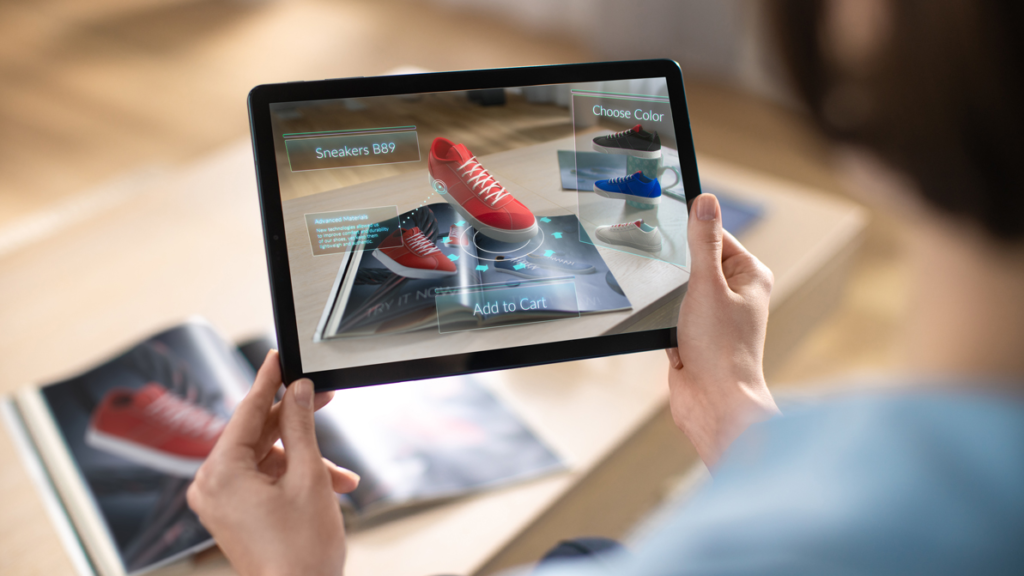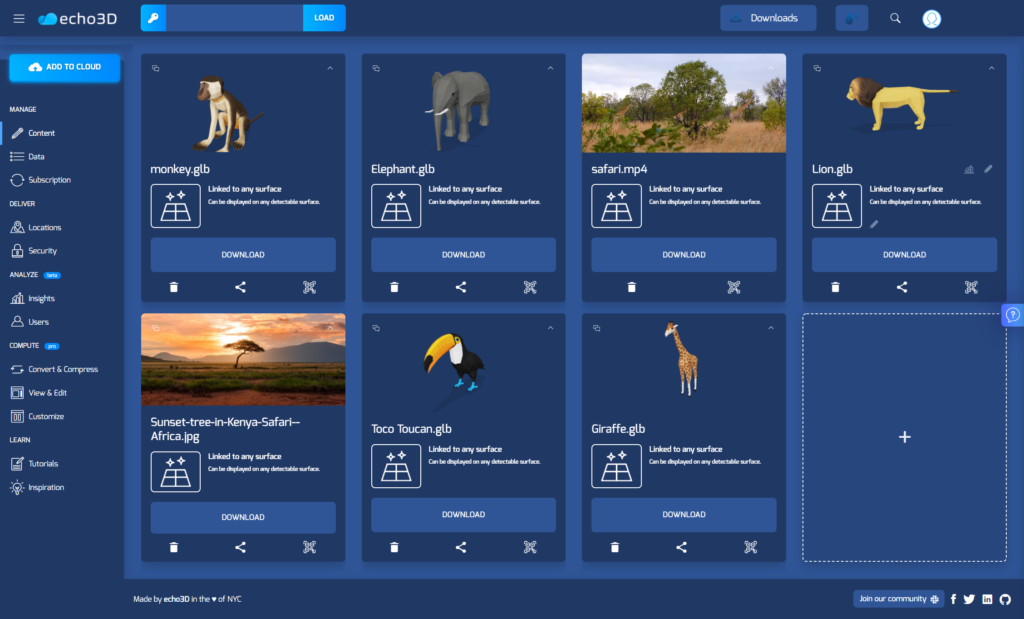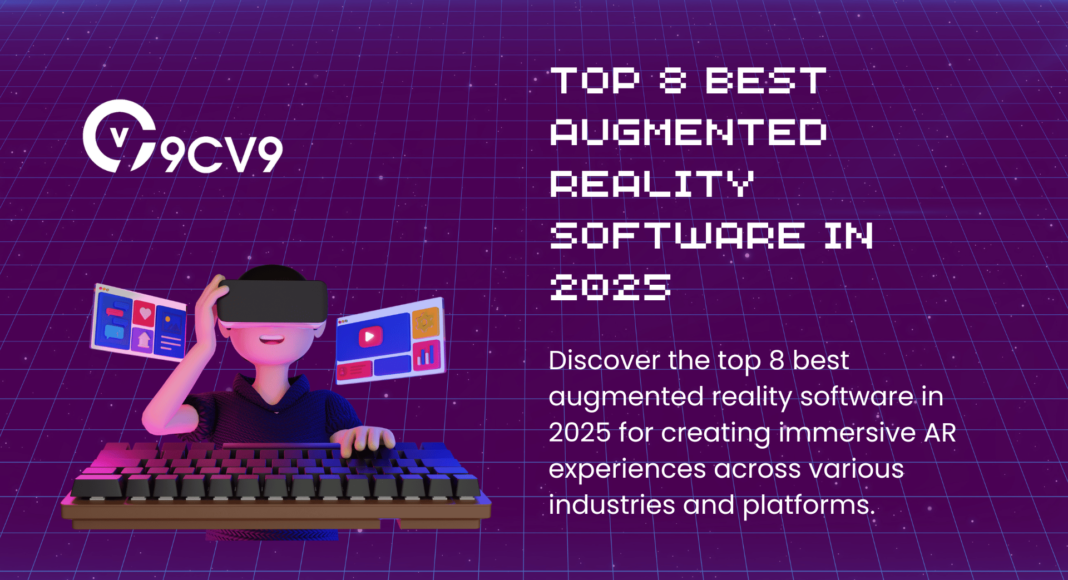Key Takeaways
- Discover the best augmented reality software in 2025, from Unity’s powerful AR tools for immersive experiences to Google’s ARCore for cross-platform development.
- Wikitude and ARToolKit provide flexible, multi-platform solutions for developers and businesses.
- Leverage advanced AR technologies such as motion tracking, object recognition, and geolocation to create engaging, real-world interactive experiences with top AR software.
Augmented Reality (AR) technology continues to evolve at an exponential rate, transforming industries and offering innovative ways to enhance user experiences.
In 2025, the realm of AR has reached new heights, with sophisticated software solutions redefining how we interact with the digital and physical worlds.
From gaming and entertainment to education, healthcare, retail, and beyond, AR has become a vital tool for businesses looking to engage their customers in immersive, interactive environments.
As companies strive to stay ahead in this rapidly developing field, selecting the right AR software has become crucial for success.
The best AR software in 2025 offers powerful features, versatility, and seamless integration with existing technologies.
With the demand for AR solutions skyrocketing, it is essential for professionals to leverage the most effective and innovative tools available to ensure that their projects not only meet but exceed user expectations.
In this comprehensive guide, we will explore the Top 8 Best Augmented Reality Software in 2025, carefully curated to showcase the latest advancements and trends.
Whether you’re a developer, marketer, educator, or business owner, these cutting-edge AR software options will empower you to create immersive digital experiences that bridge the gap between reality and imagination.
From ease of use to customization options and cross-platform compatibility, we’ll dive deep into each tool’s unique strengths and features, helping you make an informed decision based on your specific needs and goals.
By the end of this blog, you will have a clear understanding of which AR software best aligns with your objectives, setting you on the path to creating remarkable AR applications that captivate audiences and drive innovation across industries.
So, whether you’re looking to develop AR applications for marketing campaigns, education tools, virtual try-ons, or other applications, the tools we highlight in this guide are the cornerstone of AR success in 2025.
Let’s explore how these top AR software solutions are revolutionizing the world of augmented reality.
Before we venture further into this article, we would like to share who we are and what we do.
About 9cv9
9cv9 is a business tech startup based in Singapore and Asia, with a strong presence all over the world.
With over nine years of startup and business experience, and being highly involved in connecting with thousands of companies and startups, the 9cv9 team has listed some important learning points in this overview of the Top 8 Best Augmented Reality Software in 2025.
If your company needs recruitment and headhunting services to hire top-quality employees, you can use 9cv9 headhunting and recruitment services to hire top talents and candidates. Find out more here, or send over an email to [email protected].
Or just post 1 free job posting here at 9cv9 Hiring Portal in under 10 minutes.
Top 8 Best Augmented Reality Software in 2025
1. Vuforia

Vuforia stands as one of the leading Augmented Reality (AR) software platforms in 2025, renowned for its exceptional capabilities and versatility in developing cutting-edge AR experiences.
As an AR Software Development Kit (SDK), it has earned its place at the top of numerous AR software rankings, and its comprehensive suite of tools makes it an indispensable choice for developers and businesses aiming to create dynamic AR applications.
One of the primary reasons Vuforia continues to excel is its range of robust features tailored to enhance object recognition and 3D modeling, ensuring it meets the needs of a variety of industries.
The software supports both marker-based and markerless AR, allowing for more flexibility in AR design.
Notable features such as Ground Plane, which facilitates the placement of content on horizontal surfaces, and Visual Camera, which expands the scope of supported visual sources beyond mobile devices, are among the standout offerings that make Vuforia an industry leader.
Additionally, VuMarks enable the use of custom markers for face recognition and data encoding, further enhancing its adaptability.
Vuforia’s Extended Tracking feature also significantly sets it apart. This innovative tool ensures that objects remain in view even when they leave the frame, a feature that supports immersive, user-centric AR applications where digital content seamlessly surrounds the user.
The inclusion of Smart Terrain further enhances its utility, providing developers with the ability to create interactive environments that adapt to real-world surroundings, making it an excellent tool for applications requiring advanced spatial mapping.
What truly elevates Vuforia as one of the Top AR Software in 2025 is its multi-platform support, which allows developers to deploy solutions across Android, iOS, Universal Windows Platform, and the Unity Editor.
Such versatility ensures that AR experiences created with Vuforia can reach a broader audience, making it a preferred choice for businesses and developers aiming to deliver scalable and cross-platform solutions.
Vuforia’s Object Scanner feature is another valuable tool, allowing the recognition of both 2D and 3D objects, while its Text Recognition functionality includes an extensive built-in vocabulary of over 100,000 English words, along with the option to customize it for specific use cases.
The inclusion of VuMarks, barcodes that can serve as markers or contain data, and Video Playback capabilities, which trigger content based on specific conditions, further solidifies Vuforia’s standing in the market.
Moreover, the platform allows for Virtual Buttons that can turn any surface into a touchscreen interface, contributing to a more interactive AR experience.
For enterprises seeking to leverage AR for business solutions, Vuforia’s support for smart glasses and its ability to store data locally or in the cloud makes it a reliable platform for integrating AR into commercial operations.
While Vuforia is available for free, its limited functionality and watermarking make the free version more suitable for hobbyists.
Developers and businesses, however, will likely find more value in the paid subscription plans, including the Classic ($499 per instance) and Cloud ($99 per month) plans, or the customizable Pro plan for commercial use.
Furthermore, Vuforia goes beyond just being a development tool—it incorporates security features such as content encryption, secure authentication, and multi-layered application security management.
This makes the platform not only powerful but also secure, an essential consideration when handling sensitive business data.
Its support for AI, multi-platform access, and cloud storage facilities ensures that developers have all the tools they need to create cutting-edge, secure, and scalable AR solutions.
In conclusion, Vuforia stands as a premier choice for AR developers in 2025, offering a comprehensive suite of tools and advanced features for creating immersive, business-ready AR applications.
Its extensive capabilities, including multi-platform support, object recognition, and secure, customizable solutions, make it a go-to AR platform for developers aiming to craft high-quality AR experiences.
2. Echo3D

Echo3D emerges as one of the top augmented reality (AR) software solutions in 2025, primarily due to its specialized focus on delivering high-performance cloud services tailored for 3D, AR, and virtual reality (VR) applications. By offering a robust infrastructure capable of handling complex 3D data and delivering it seamlessly in real-time, echo3D has established itself as a standout choice for developers and businesses aiming to build and deploy cutting-edge AR/VR experiences. This exceptional ability to handle intricate 3D data efficiently makes it an indispensable platform for any AR/VR project that requires high performance and scalability.
The reason echo3D earns its place among the best AR software platforms in 2025 is its specialized expertise in the AR/VR niche. While many cloud service providers cater to a wide range of industries, echo3D’s emphasis on supporting 3D, AR, and VR applications sets it apart from the competition. Unlike general-purpose cloud platforms, echo3D is specifically designed to address the unique challenges of AR and VR development, making it an ideal choice for businesses focused on delivering immersive, high-quality experiences. The platform’s ability to manage complex 3D data in real-time, without sacrificing performance, positions echo3D as a key player in the AR/VR development landscape.
Echo3D’s set of standout features further enhances its appeal. The platform provides real-time 3D streaming, content optimization, and advanced 3D search capabilities, making it an essential tool for developers who need to manage and deploy 3D assets efficiently. With a flexible cloud infrastructure and a powerful content management system (CMS), echo3D allows developers to quickly build, scale, and optimize their AR and VR applications. The integration with popular 3D engines like Unity and Unreal Engine extends the platform’s reach, ensuring compatibility with the majority of AR/VR development workflows. This seamless integration simplifies the development process and enables developers to leverage powerful engines to create next-level AR and VR experiences.
Echo3D’s cloud platform, echoAR, is built to streamline the development and delivery of AR and VR applications. By providing developers with an intuitive backend system, echoAR empowers them to manage and publish 3D content efficiently. Its scalable Backend-as-a-Service (BaaS) infrastructure supports the synchronization of data across users, while its global Content Delivery Network (CDN) ensures that users experience fast, secure, and reliable access to the 3D content within their applications. This infrastructure is vital for delivering smooth, real-time AR and VR experiences, which is critical in today’s highly competitive digital landscape.
In addition to its technical features, echo3D excels in providing key benefits to developers and businesses looking to deploy 3D, AR, and VR apps:
- Efficient tools for building and scaling 3D apps: Echo3D’s platform simplifies the process of creating, scaling, and managing AR and VR applications, enabling developers to focus more on content and less on infrastructure.
- Comprehensive content management system (CMS): The CMS allows developers to easily manage 3D assets and content, ensuring seamless integration across platforms.
- Cross-platform API support: The platform supports a cross-platform API, which enables developers to publish and retrieve 3D assets on various devices and environments.
- Global CDN for fast content delivery: Echo3D leverages a CDN to ensure users receive reliable, secure, and lightning-fast access to AR and VR content, regardless of their geographical location.
- Scalable BaaS infrastructure: The scalable backend infrastructure synchronizes user data and automatically compresses and converts 3D assets, making it easier for businesses to scale their applications and deliver high-performance experiences.
- Real-time insights on user engagement: Echo3D provides developers with analytics on user engagement, offering valuable data that can be used to optimize app performance and user experience.
In conclusion, echo3D’s specialization in AR, VR, and 3D data management, combined with its powerful cloud infrastructure and seamless integrations, makes it a premier choice for developers and businesses in 2025. Its comprehensive set of features, high-performance capabilities, and global reach position it as one of the most reliable and efficient platforms for creating and delivering AR and VR applications. Whether developing a new AR app, scaling an existing VR experience, or managing 3D content, echo3D provides the necessary tools and infrastructure to bring innovative ideas to life with ease and efficiency.
3. Unity

Unity stands as one of the leading software platforms for augmented reality (AR) development in 2025, renowned for its ability to create immersive, highly interactive AR experiences that seamlessly blend the digital and physical worlds. This powerful tool is particularly valued for its robust set of resources and a cutting-edge software development platform, tailored specifically for AR creators. As a versatile solution, Unity is employed across a broad spectrum of industries, including automotive, manufacturing, government, architecture, energy, and retail. Its adaptability to various sectors showcases its strength in fostering creative innovation and pushing the boundaries of augmented reality technology.
What makes Unity a standout AR tool in 2025 is its holistic and unified approach to AR development. Unity’s workflow is designed to extend across multiple devices and platforms, ensuring that developers can maintain consistency and quality regardless of the end-user’s hardware. The software’s AR Foundation serves as a cross-platform framework, enabling developers to write AR experiences that are compatible with both Android and iOS devices. This ensures that AR applications can reach a broad audience while maintaining the integrity and performance of the experience.
Unity is best known for its legacy in game development, but it has evolved into a highly versatile platform that supports the creation of applications in various fields, including AR, VR, and 3D modeling. The software’s powerful features, such as its custom scripting tools and industry-leading platform, allow developers to craft applications that provide rich, deeply engaging AR experiences. Unity’s integration of purpose-built tools for AR creators enables the production of high-quality AR applications that respond intelligently to real-world environments. This allows for the development of AR experiences that are both interactive and context-aware, offering users a truly immersive digital environment.
Beyond gaming, Unity is leveraged in sectors that demand precision and innovative design, such as architecture, engineering, and industrial design. Its ability to filter and manipulate Building Information Modeling (BIM) data, collaborate with stakeholders on design reviews, and visualize complex models in AR has made it an essential tool for professionals working in these industries. The software’s capabilities extend to enhancing the AR experience by allowing users to interact with and visualize virtual models in real-world spaces, making it invaluable for product design, prototyping, and training simulations.
Another notable strength of Unity is its integrated development environment (IDE), which combines a powerful C# scripting API, built-in Visual Studio integration, and robust animation tools. This synergy of resources empowers developers to create highly customized AR experiences that not only meet industry standards but also push creative boundaries. Unity’s versatility allows teams to personalize elements such as splash screens and in-app interfaces, providing a tailored experience for both developers and end-users.
Unity’s popularity within the game development community is undeniable, with iconic games like Pokémon Go, Hearthstone, and RimWorld being built on the platform. The combination of a dynamic, intuitive interface and a range of powerful tools has made Unity a preferred choice for game developers, designers, and artists alike. Its wide-ranging capabilities and reputation for delivering high-quality digital experiences have contributed significantly to its continued success in both the AR and gaming industries.
In summary, Unity’s position as one of the top augmented reality software solutions in 2025 is attributed to its industry-leading development tools, cross-platform compatibility, and ability to create deeply interactive, immersive AR experiences. With its robust AR Foundation framework, extensive integration capabilities, and versatility across industries, Unity remains a top choice for developers looking to push the limits of augmented reality technology. Whether for gaming, architectural design, or industrial applications, Unity offers an unparalleled platform for crafting next-generation AR experiences that continue to shape the future of interactive digital media.
4. ARCore

Google’s ARCore stands as one of the most advanced augmented reality (AR) platforms in 2025, offering a comprehensive suite of tools that seamlessly integrate virtual content into real-world environments. With a robust set of features, ARCore empowers developers to create AR experiences that engage users through highly interactive, dynamic content. The software’s key capabilities—motion tracking, surface detection, and lighting estimation—enable it to produce sophisticated AR applications that respond to the physical world with impressive accuracy and realism.
ARCore’s standout feature lies in its ability to allow 3D objects to be rendered across multiple devices simultaneously, fostering seamless interactions between users and their environments. Whether the user is working with Android, iOS, or popular game engines like Unreal and Unity, ARCore ensures that the AR experience remains consistent and immersive. This platform also integrates with Google’s Tilt Brush for 3D drawing, allowing developers to create stunning visual content that interacts fluidly with the physical world.
At the heart of ARCore’s technology is its three core principles, which work harmoniously to embed virtual elements into real environments. These technologies—motion tracking, environmental recognition, and lighting estimation—are crucial for delivering a truly immersive AR experience. By using sophisticated motion tracking algorithms, ARCore can precisely monitor the phone’s movement and its position relative to surrounding objects, ensuring that virtual content remains aligned with the real world. Additionally, ARCore’s environmental recognition system can detect surfaces, measure their dimensions, and accurately place virtual objects onto these surfaces. Whether it’s a table, floor, or any other horizontal plane, objects remain firmly “anchored” in place, even as the user moves around.
Lighting estimation is another key feature of ARCore that enhances the realism of virtual content. Through this feature, 3D models respond to changes in the environment’s lighting, adjusting their appearance to match the surrounding conditions. This means that virtual objects cast shadows, reflect light, and interact with the environment in a way that feels entirely natural. Importantly, ARCore uses proprietary camera technology to capture the parameters of physical objects and surfaces, ensuring that these virtual elements appear grounded in the real world, unaffected by the phone’s motion.
ARCore is highly versatile, supporting a wide range of platforms and development environments. It is compatible with Android 7.0+, iOS 11+, Android NDK, and both Unity and Unreal Engine for creating rich, interactive AR experiences. This cross-platform flexibility enables developers to build apps that work seamlessly across different devices, allowing them to reach a broader audience. Additionally, the integration with Google’s Blocks VR building tools further enhances the platform’s utility, enabling the creation of 3D models that can be used in a variety of AR applications.
One of the most compelling reasons why ARCore stands among the top AR software in 2025 is its accessibility. As a free tool, ARCore is available to millions of Android users worldwide, making it an attractive option for developers looking to create high-quality AR applications without incurring additional costs. Beyond its cost-effective nature, ARCore is equipped with a suite of security features designed to protect user data. These include encryption, Safe Browsing, security checks, and two-step verification, ensuring that users’ personal information remains secure while interacting with AR content.
ARCore also utilizes AI to enhance user experiences by suggesting relevant products and services based on the user’s preferences and interactions. This intelligent system not only improves the user experience but also offers developers valuable insights into how their AR content is engaging users.
Furthermore, ARCore’s support for cloud storage enables the development of multi-platform applications. ARCore-powered apps can easily be accessed across different devices, further expanding the reach of AR experiences and ensuring that users can enjoy them across a variety of environments.
In conclusion, Google’s ARCore is a powerful, versatile, and accessible augmented reality platform that continues to evolve in 2025. Its advanced motion tracking, environmental recognition, and lighting estimation technologies allow developers to create truly immersive, realistic AR experiences that adapt to the real world. With its broad platform support, security features, and AI-driven enhancements, ARCore remains a top contender for anyone seeking to build cutting-edge AR applications. Its accessibility, combined with the potential for cross-platform development, ensures that ARCore will continue to play a central role in the future of augmented reality.
5. Vossle

Vossle has emerged as a standout contender in the augmented reality space in 2025, earning its place among the top AR software for its innovative and user-friendly approach. It redefines AR content creation by offering a DIY platform that requires no coding expertise, allowing users to craft WebAR experiences directly from their web browsers in under a minute. This accessibility empowers businesses, educators, and marketers to quickly adopt AR technology without needing technical skills or extensive resources.
What sets Vossle apart is its versatility in supporting diverse AR applications, including Try-On Experiences, AR Games, and Green Screen Chroma Key videos. These features make it an invaluable tool for industries such as retail, education, and e-commerce. For instance, marketers can create engaging AR campaigns that enhance customer interaction, while e-commerce platforms can leverage AR for immersive product visualization, allowing customers to “try before they buy.”
Moreover, Vossle’s support for geolocation-based AR and image recognition expands its use cases, enabling brands to craft dynamic, location-specific campaigns that capture consumer attention. Its quick deployment capabilities ensure that businesses can integrate AR into their strategies efficiently, reducing time-to-market while maximizing impact.
By removing the technical barriers to AR development, Vossle democratizes the use of augmented reality, allowing organizations of all sizes to explore its potential. For companies seeking a rapid, effective, and accessible AR solution, Vossle offers a compelling choice, solidifying its reputation as one of the best augmented reality software tools of 2025.
6. JigSpace

JigSpace has solidified its position as one of the premier augmented reality (AR) tools in 2025, distinguished by its ability to revolutionize how we experience, learn, and communicate complex concepts. As the world’s highest-rated AR application, JigSpace excels in offering a comprehensive platform for creating, exploring, and sharing truly interactive 3D content. Whether for education, professional training, or sales presentations, JigSpace empowers users to engage with information in an entirely new way, making it an indispensable tool for those seeking immersive and intuitive AR experiences.
Why JigSpace Stands Out in 2025
The core appeal of JigSpace lies in its unique ability to transform traditional learning and presentation methods by leveraging AR technology. Unlike standard 2D images or static diagrams, JigSpace offers users the opportunity to explore and interact with information in three-dimensional space. This immersive approach to learning mirrors how we naturally perceive the world—through depth, perspective, and interaction—making it an ideal tool for both educational and professional purposes.
JigSpace provides a platform that answers the question, “How does this work?” by bringing those answers to life in beautiful, detailed 3D visuals. Whether exploring the inner workings of machinery, understanding scientific phenomena, or diving into product assemblies, JigSpace allows users to interact with the content directly, fostering a more engaging and intuitive learning environment. With a vast library of interactive “Jigs,” users can delve into an array of topics and satisfy their curiosity at their own pace.
Key Features That Make JigSpace a Top AR Software
One of the standout features of JigSpace is its emphasis on ease of use, making it accessible to a wide range of users, from students and educators to professionals in various industries. The platform’s intuitive interface allows users to quickly create and share AR experiences, making it an excellent tool for diverse applications, from school assignments to corporate presentations.
The ability to create interactive 3D breakdowns of complex ideas, products, and phenomena is another reason why JigSpace is highly regarded. This feature allows users to present information in an engaging and easy-to-understand format, ensuring that intricate concepts are simplified through visually interactive models. Whether it’s a step-by-step guide for assembly instructions or a breakdown of a product’s inner workings, JigSpace offers unparalleled clarity and depth.
In addition to its interactive learning capabilities, JigSpace provides a growing library of Jigs—an extensive collection of pre-made, immersive AR experiences. With dozens of topics to explore, users can browse through a range of learning materials that cover everything from technology and engineering to art and history. This evolving library ensures that there is always something new to discover, keeping users engaged and motivated to continue learning.
Enhanced Collaboration and Customization Options
JigSpace offers powerful tools for customization, enabling users to import their own 3D files, integrate photorealistic materials, and utilize more than 1,000 3D objects from its library. This flexibility makes it a versatile tool for a wide range of industries, from education to product design and sales presentations. By allowing users to create unique, personalized AR experiences, JigSpace stands out as a tool that can be tailored to meet individual or business needs.
Another remarkable feature of JigSpace is its capability to host multi-user remote presentations, a function that is particularly valuable for team collaboration and virtual learning environments. Whether conducting a remote training session, demonstrating a product, or delivering an interactive presentation, the ability to host live, collaborative sessions within the AR space enhances engagement and provides a more immersive experience for all participants.
Applications Across Industries
JigSpace is rapidly becoming an essential tool across various sectors. In education, it allows students to engage with complex scientific concepts, historical artifacts, and engineering principles in ways that were previously not possible. For corporate training, businesses can use JigSpace to create dynamic, interactive materials that enhance understanding and retention, making it an invaluable resource for onboarding, skills development, and product training. In sales, the ability to showcase products in 3D, demonstrate assembly procedures, and walk clients through intricate features creates a more impactful and memorable customer experience.
Conclusion: JigSpace’s Role Among the Best AR Tools of 2025
In 2025, JigSpace is an undeniable leader in the augmented reality space, offering a versatile, user-friendly platform that bridges the gap between static information and immersive, interactive learning. Its ability to deliver high-quality 3D breakdowns, coupled with powerful customization options and an ever-expanding library, makes it an essential tool for anyone looking to enhance their understanding, presentation, or communication of complex concepts. Whether for educational purposes, corporate use, or creative exploration, JigSpace continues to empower users to bring knowledge to life in ways that were once unimaginable. This combination of cutting-edge features and ease of use places JigSpace among the top AR software available today.
7. Wikitude

Wikitude has quickly emerged as one of the top contenders in the augmented reality (AR) software landscape, earning its place as one of the most reliable and flexible development platforms for AR applications in 2025. Founded in 2008, this relatively young company has already made a significant mark in the AR industry, garnering attention for its robust set of tools that cater to developers working on projects across various platforms, including iOS, Android, and Smart Glasses devices. The ongoing debate between Vuforia and Wikitude has highlighted the latter’s growing influence and its ability to provide powerful AR development solutions for diverse industries.
Why Wikitude is Among the Best AR Development Tools
What sets Wikitude apart from other AR platforms is its versatility and adaptability. Developers seeking to create AR applications can leverage Wikitude’s range of features to build rich, interactive experiences that integrate seamlessly into real-world environments. It supports an array of tracking methods, such as image recognition, object recognition, and SLAM (Simultaneous Localization and Mapping), making it one of the most capable tools for developing immersive AR experiences. Additionally, Wikitude’s incorporation of geolocation and distance-based scaling enables developers to create location-aware applications that offer unique, context-sensitive user experiences.
Wikitude is a multi-platform development tool that allows users to create AR experiences for Android, iOS, and even certain smart glasses and tablets. The platform’s compatibility with multiple devices ensures that the apps developers create can reach a wide audience, whether on smartphones, tablets, or wearables. This flexibility is crucial for businesses and developers looking to target diverse user bases across various operating systems.
Key Features that Elevate Wikitude’s Capabilities
A standout feature of Wikitude is its SLAM technology, which allows for real-time tracking of objects and scenes in dynamic environments. By using this technology, developers can create AR applications that do not rely on predefined markers, enabling the creation of highly interactive and fluid AR experiences. This ability to track and map objects instantly is particularly valuable in industries such as retail, tourism, and education, where users expect to interact with objects and environments in real-time.
In addition to its core tracking capabilities, Wikitude integrates geolocation and image tracking to enable location-based experiences. This combination of features is ideal for developing AR applications that can provide users with location-specific information, such as historical facts, product details, or guided tours. The ability to integrate these technologies means that Wikitude is particularly suited for navigation apps, location-based games, and other context-aware applications.
Wikitude also incorporates cloud recognition, which allows for the recognition of objects in the real world by comparing them with pre-stored data in the cloud. This is particularly useful for businesses that want to build scalable, cloud-based AR solutions that can deliver personalized content to users based on their location and interactions. With cloud storage support, Wikitude enables developers to manage large datasets efficiently, ensuring a smooth experience for end users.
Flexible and Customizable for Developers
One of Wikitude’s strongest features is its flexibility. It provides developers with the ability to retrieve 3D objects from third-party SDKs and integrate them into their AR applications. This means that developers can work with a wide variety of assets and tools from other platforms, expanding the scope of what they can create. The platform’s customization options allow developers to design AR solutions tailored to specific business needs, whether it’s a product showcase, an educational experience, or a marketing campaign.
Wikitude is an excellent choice for mobile app development and prototype creation. It enables developers to design interactive, immersive experiences that can be easily tested and iterated upon. The platform’s ability to work with image tracking and object recognition also makes it a popular choice for businesses in sectors like e-commerce and advertising, where engaging visual content can significantly enhance customer interaction.
Considerations for Premium Features
While Wikitude offers a free version, access to its premium features requires a membership. These premium features provide additional capabilities, such as advanced tracking, cloud recognition, and extended support, which can be crucial for developers working on more complex projects. Businesses looking to integrate AR into their products or services on a larger scale may find these premium features to be an invaluable addition to their development toolkit.
Conclusion: Wikitude’s Role in Shaping the AR Landscape in 2025
In 2025, Wikitude remains one of the top choices for AR software development, thanks to its powerful combination of flexibility, real-time tracking, geolocation integration, and cloud recognition. The platform’s ability to support multi-platform development ensures that AR applications built with Wikitude can reach a wide range of devices, making it an attractive option for developers and businesses alike. Its focus on customization and ease of integration with third-party tools further cements its reputation as a comprehensive AR solution for a variety of industries. As AR technology continues to evolve, Wikitude’s adaptability and feature-rich environment will undoubtedly play a significant role in shaping the future of augmented reality development.
8. ARToolKit

ARToolKit stands as one of the most well-regarded open-source libraries for augmented reality (AR) development, offering a robust foundation for creating immersive AR experiences. Despite being an open-source tool, ARToolKit provides developers with a range of powerful features that make it a top choice for building AR applications in 2025. The platform leverages cutting-edge computer vision algorithms to track user viewpoints, enabling developers to create applications that can accurately place virtual objects in the real world based on camera position and orientation relative to physical markers.
Why ARToolKit Remains a Leading AR Software Tool in 2025
ARToolKit is known for its versatile compatibility with multiple operating systems, including Android, iOS, Windows, Linux, SGI, and Mac OS X, making it an ideal choice for developers targeting a wide range of platforms. Its ability to support cross-platform development enables AR experiences to be seamlessly integrated across different devices and environments. This cross-compatibility positions ARToolKit as a top-tier AR software solution, offering the flexibility required to meet the needs of a diverse audience and expanding the reach of AR applications.
At its core, ARToolKit relies on marker recognition technology, using square object markers to anchor virtual elements in the real world. The platform processes graphic data captured by the mobile camera in real-time, allowing virtual objects to be placed accurately based on their spatial location relative to these markers. This real-time marker tracking allows for the creation of highly interactive and realistic AR experiences, ideal for applications in fields such as education, gaming, retail, and industrial training.
ARToolKit’s ability to support both 2D and 3D image processing sets it apart from many other AR platforms. The library’s use of OpenGL specifications in combination with GLUT libraries enables developers to create high-performance graphics that are essential for rendering complex AR experiences. These features are particularly valuable when developing applications that require detailed 3D models, animations, and other graphic-heavy elements that need to be accurately overlaid onto the real-world environment.
Key Features and Advantages of ARToolKit
- Marker-Based AR Development: The primary principle behind ARToolKit’s operation is its ability to recognize square markers placed in the real world. These markers serve as anchors for virtual objects, which are displayed on the device’s screen, maintaining their correct position and orientation in space. This form of marker recognition enables developers to create precise AR experiences that align virtual content with the physical world.
- Cross-Platform Support: ARToolKit supports a wide array of operating systems, including iOS, Android, Windows, Linux, SGI, and Mac OS X. This extensive compatibility ensures that AR applications developed with ARToolKit can reach users across a variety of devices, from smartphones and tablets to desktop computers, offering flexibility for developers working across multiple ecosystems.
- Real-Time Camera Tracking: One of the standout features of ARToolKit is its camera tracking capability. The software can track the camera’s position and orientation in real time, ensuring that virtual objects remain correctly aligned and positioned, no matter how the user moves or shifts their viewpoint. This real-time tracking is essential for creating dynamic and interactive AR environments that respond fluidly to user input.
- Support for Custom Markers: ARToolKit allows for the use of a variety of square marker templates, including the ability to create custom markers. This versatility in marker recognition makes it easier for developers to create tailored AR experiences based on specific use cases, from advertising to interactive exhibits.
- OpenGL and GLUT Libraries: The integration of OpenGL and GLUT libraries enhances the graphical capabilities of ARToolKit, allowing developers to render high-quality 3D models and interactive visuals. This feature is crucial for building complex AR applications that require smooth graphics and realistic object interactions.
- Simple Camera Calibration: ARToolKit provides straightforward camera calibration tools, which simplify the process of ensuring that the device’s camera is properly aligned for AR development. This ease of use is particularly beneficial for developers new to AR, as it reduces the complexity of the setup process.
Considerations and Limitations of ARToolKit
While ARToolKit offers impressive features for developers, it is worth noting that its documentation is still a work in progress. The platform’s resources may not always include comprehensive use cases or detailed tutorials, which can pose a challenge for newcomers to AR development. However, the presence of numerous tutorials on platforms like YouTubehas helped to fill in this gap, providing users with valuable learning materials to navigate the tool effectively.
Moreover, while ARToolKit excels in its core features, it may not be as advanced in certain areas as some proprietary AR development tools. Developers seeking more advanced functionalities, such as cloud-based recognition or multi-user interaction, may need to look at other software solutions.
Conclusion: Why ARToolKit is a Top AR Development Tool in 2025
ARToolKit’s standing as one of the best AR software tools in 2025 is underscored by its combination of cross-platform compatibility, real-time tracking, and marker-based AR development. Despite being an open-source library, ARToolKit provides developers with a robust and flexible toolkit for creating interactive, high-performance AR applications. Its integration of OpenGL, GLUT, and support for custom markers allows for the development of visually captivating AR experiences. While there are some limitations in documentation and advanced features, ARToolKit remains a go-to choice for developers looking to create accessible and scalable augmented reality solutions for a variety of platforms.
Conclusion
As we move further into the digital age, augmented reality (AR) is reshaping how businesses and individuals interact with the world around them. The best AR software in 2025 is enabling a broad range of applications—from gaming and education to marketing and healthcare—allowing for more immersive, dynamic, and interactive experiences than ever before. Whether you’re a developer, business owner, educator, or hobbyist, the power of AR software provides opportunities to transform ideas into reality.
In this rapidly evolving field, the top 8 AR software solutions discussed in this article represent the cutting edge of augmented reality technology. These tools have been carefully selected for their unique features, flexibility, and the transformative potential they offer in creating engaging AR experiences. Here’s why each of these platforms stands out as the best in the industry in 2025.
Vuforia, one of the industry’s leaders, is known for its robust tracking capabilities and broad compatibility across mobile devices and wearables. With its cloud recognition, multi-device support, and real-time tracking technology, Vuforia remains the go-to platform for enterprise-level AR applications. It is widely recognized for its precision, making it ideal for product visualization, training modules, and marketing campaigns.
JigSpace offers a unique approach to AR, focusing on interactive, 3D learning experiences. Its user-friendly design allows anyone to create and share educational content through Jigs, whether it’s for school projects, professional training, or sales presentations. The ability to import 3D models and use over 1,000 photorealistic objects makes it a versatile solution for educators, trainers, and businesses looking to deliver highly engaging content.
Wikitude stands out for its flexibility and powerful geolocation-based AR development. Its use of SLAM(Simultaneous Localization and Mapping) and image recognition allows for precise location-based AR experiences, which is particularly useful in industries like tourism, navigation, and retail. Whether you’re looking to create AR applications for mobile devices or smart glasses, Wikitude provides a comprehensive toolkit that supports multiple platforms and advanced tracking technologies.
For those looking to create marker-based AR solutions, ARToolKit is an open-source gem that enables marker recognition and camera tracking for both 2D and 3D images. Despite some limitations in documentation, ARToolKit remains a top choice for developers who prefer the flexibility of open-source software to create custom AR applications. Its wide compatibility across Android, iOS, Windows, and Linux platforms makes it highly accessible, while its support for OpenGL and GLUT libraries adds value for those looking to create high-quality, graphic-intensive AR experiences.
Each of these AR tools brings something unique to the table, but they all share one common trait: the ability to create powerful, immersive AR experiences that are transforming the way we perceive and interact with the world. These platforms are not just limited to entertainment—they’re being used to solve real-world problems, whether it’s through interactive training, virtual product try-ons, or enhanced retail experiences.
Looking ahead, the potential for augmented reality in 2025 and beyond is vast. As technology continues to evolve, these tools are likely to introduce even more advanced features, including enhanced AI integration, real-time collaboration, and cloud-based AR experiences, further expanding the scope of what AR can achieve. The rise of 5G networks and advancements in wearables such as smart glasses will only accelerate the adoption of AR software, allowing for faster rendering, better interactivity, and wider accessibility.
In conclusion, choosing the best AR software for your project in 2025 depends largely on your specific needs. Whether you are creating immersive training experiences, interactive marketing campaigns, or simply exploring new ways to engage with your audience, there is an AR tool tailored to your objectives. Each of the software solutions discussed here has proven to be at the forefront of augmented reality development, offering a range of features, compatibility, and ease of use that will help bring your creative ideas to life. By leveraging the best AR tools of 2025, businesses and creators can unlock the potential of augmented reality and revolutionize the way people interact with digital content and the physical world.
If you find this article useful, why not share it with your hiring manager and C-level suite friends and also leave a nice comment below?
We, at the 9cv9 Research Team, strive to bring the latest and most meaningful data, guides, and statistics to your doorstep.
To get access to top-quality guides, click over to 9cv9 Blog.
People Also Ask
What is Augmented Reality (AR) software?
Augmented Reality software allows digital content to be integrated with the physical world in real-time. It enhances user experiences by overlaying virtual elements like images, sounds, or data onto physical surroundings through devices like smartphones, tablets, or AR glasses.
What is the best AR software in 2025?
The best AR software in 2025 includes Unity, Google ARCore, JigSpace, Wikitude, and ARToolKit, as they offer advanced features, flexibility, and compatibility across various platforms, making them ideal for both developers and businesses.
What makes Unity one of the top AR software choices in 2025?
Unity is known for its powerful AR development tools, offering AR Foundation for cross-platform experiences and seamless integration with AR tools. Its flexibility in supporting industries like gaming, automotive, and retail makes it a top choice in 2025.
How does ARCore enhance augmented reality experiences?
ARCore enables advanced features like motion tracking, environmental recognition, and lighting estimation. It allows seamless integration of virtual content with real-world environments and supports development for both Android and iOS devices.
What features does JigSpace offer for AR learning?
JigSpace allows users to create and view interactive 3D breakdowns of complex ideas and products in AR. Its user-friendly interface makes it ideal for learning, teaching, and creating educational materials, offering over 1,000 3D objects and tools for customization.
How does Wikitude support AR development?
Wikitude offers a flexible AR platform that supports image tracking, geolocation, and object recognition. With multi-platform compatibility, it provides developers the ability to create AR apps for Android, iOS, and even smart glasses, making it highly versatile.
What are the benefits of using ARToolKit for AR app development?
ARToolKit is an open-source AR software that uses marker recognition for developing AR applications. It supports both 2D and 3D images and is ideal for developers looking to create solutions across various platforms like Android, iOS, Windows, and Linux.
Which AR software is best for mobile app development?
Unity, ARCore, and Wikitude are among the best AR software for mobile app development due to their cross-platform compatibility and advanced features for iOS and Android. These tools allow developers to create immersive, real-time AR experiences for mobile users.
Is Unity suitable for AR game development?
Yes, Unity is highly suitable for AR game development. Its AR Foundation, paired with Unity’s game development tools, allows developers to create immersive, interactive AR experiences for mobile and desktop devices, making it a go-to platform for AR games.
Can ARCore be used on iOS devices?
Yes, ARCore can be used on iOS devices. Although initially developed for Android, ARCore has cross-platform capabilities, supporting both Android and iOS for developing immersive AR experiences.
What industries benefit from using AR software?
Industries such as gaming, automotive, healthcare, retail, education, and manufacturing benefit significantly from AR software. These tools enhance user experiences, streamline training, improve product visualization, and enable innovative marketing campaigns.
How can businesses use AR for marketing in 2025?
Businesses can use AR software to create engaging and interactive advertisements. Through AR, they can allow customers to visualize products in their environment, creating memorable experiences that drive customer engagement and sales.
Which AR software offers the best 3D object support?
Unity, JigSpace, and ARCore offer excellent 3D object support. These platforms allow users to import, manipulate, and display 3D models, making them ideal for industries that require realistic product visualizations and interactive educational content.
What is the difference between ARCore and ARKit?
ARCore, developed by Google, supports both Android and iOS, offering features like motion tracking and environmental recognition. ARKit, developed by Apple, is designed exclusively for iOS and integrates tightly with Apple’s hardware and software ecosystem for AR experiences.
What are the advantages of using Wikitude for AR development?
Wikitude’s geolocation features, cloud recognition, and multi-platform compatibility make it an excellent choice for AR development. Its ability to integrate third-party SDKs and create customized AR experiences enhances its value for developers in various industries.
How easy is it to get started with ARToolKit?
ARToolKit is relatively easy for developers to get started with, especially those familiar with AR. Though the documentation could be improved, its open-source nature and robust marker recognition features provide a strong foundation for AR app development.
What makes JigSpace unique for educational purposes?
JigSpace’s interactive 3D breakdowns allow users to explore complex ideas and products in real time, making it a great tool for education. It’s ideal for both teachers and students to visualize and understand various concepts through immersive AR presentations.
Can AR software be used for real-time collaboration?
Yes, several AR platforms like JigSpace offer features for multi-user remote collaboration. This functionality allows teams to share and interact with AR content in real time, making it suitable for business meetings, educational environments, and creative brainstorming sessions.
What platforms does Wikitude support?
Wikitude supports a wide range of platforms including Android, iOS, Windows, and smart glasses. This makes it a versatile AR software for developers aiming to create cross-platform AR applications for various devices and environments.
How does Unity support cross-platform AR development?
Unity’s AR Foundation enables developers to build cross-platform AR experiences. With its support for both Android and iOS, Unity allows developers to create consistent and immersive AR content across multiple devices without needing to build separate applications.
What is the cost of using ARToolKit for development?
ARToolKit is free to use as it is open-source software. This makes it an attractive option for developers who are starting out or those looking for a customizable AR development tool without the cost of licensing fees.
Does ARCore support 3D object rendering?
Yes, ARCore supports 3D object rendering. It allows developers to create realistic 3D models that interact with the real world by adjusting lighting and scaling according to the environment, making AR experiences more immersive and interactive.
How does Wikitude’s cloud recognition work?
Wikitude’s cloud recognition uses the power of cloud computing to recognize and track images, objects, and locations. This feature enhances the accuracy and flexibility of AR applications by allowing recognition data to be stored and processed in the cloud.
What is the best AR software for product visualization?
Unity and ARCore are excellent choices for product visualization. Unity’s powerful rendering capabilities, combined with ARCore’s environmental recognition and lighting estimation, make these platforms ideal for creating realistic product experiences in AR.
Can ARCore be used for gaming apps?
Yes, ARCore can be used for developing gaming apps. It provides features like motion tracking and environmental understanding, allowing developers to create immersive AR games that interact with the real world in real-time.
How does JigSpace enhance the learning experience?
JigSpace enhances learning by allowing users to interact with 3D models of complex subjects. The hands-on, immersive experience helps students understand difficult concepts in a way that static images and videos cannot, making learning more engaging and effective.
Can Wikitude be used for geolocation-based AR apps?
Yes, Wikitude excels in geolocation-based AR app development. Its integration with GPS and mapping data allows developers to create location-based AR experiences, such as virtual tours or location-specific advertisements.
What type of AR apps can be developed with ARToolKit?
ARToolKit can be used to develop a wide range of AR apps, from educational tools to games and business solutions. Its marker recognition system makes it particularly suited for interactive experiences where physical objects trigger virtual content.































![Writing A Good CV [6 Tips To Improve Your CV] 6 Tips To Improve Your CV](https://blog.9cv9.com/wp-content/uploads/2020/06/2020-06-02-2-100x70.png)


